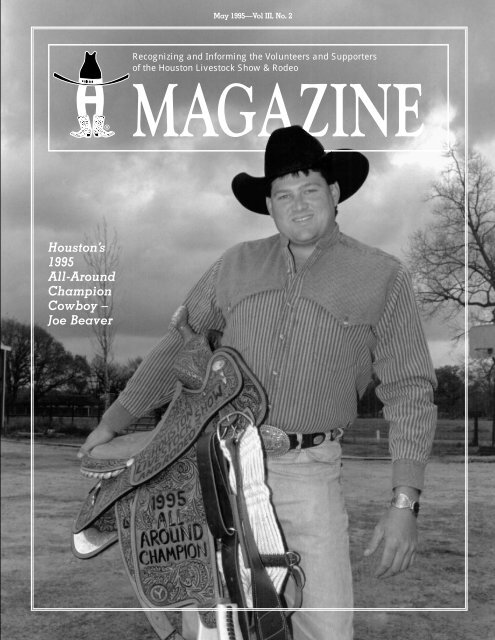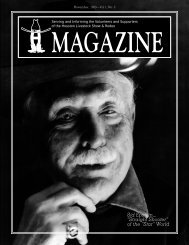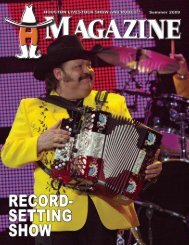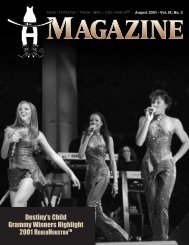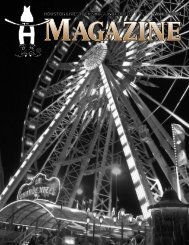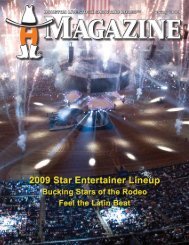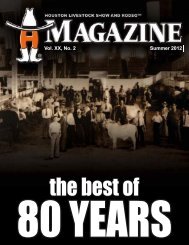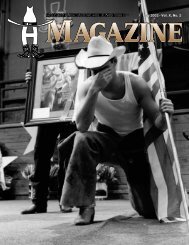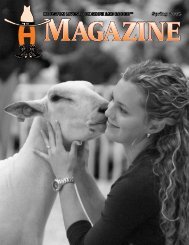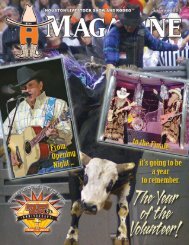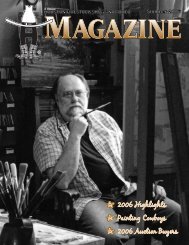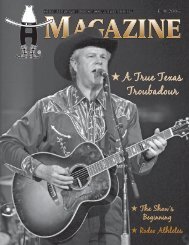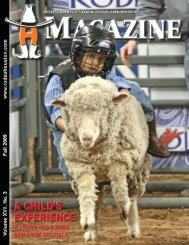Joe Beaver - Houston Livestock Show and Rodeo
Joe Beaver - Houston Livestock Show and Rodeo
Joe Beaver - Houston Livestock Show and Rodeo
You also want an ePaper? Increase the reach of your titles
YUMPU automatically turns print PDFs into web optimized ePapers that Google loves.
Sam PiersonInside the Astrodome, a crowd of more than 50,000 witnesses the selectionof the <strong>Show</strong>’s Gr<strong>and</strong> Champion Steer.lesson informing spectators aboutbeef <strong>and</strong> beef by-products used indaily life.All in all, these enhancedexhibits <strong>and</strong> attractions providedadditional enjoyment for everyone.AUCTION SALES SOAR<strong>Livestock</strong> auction records weren’tjust broken this year, they wereshattered. Four of the organization’sstaunchest supporters—LeRoy <strong>and</strong>Lucile Melcher <strong>and</strong> Tom <strong>and</strong> MarySteele—teamed up <strong>and</strong> bid anunprecedented half million dollarsfor the <strong>Show</strong>’s Gr<strong>and</strong> ChampionSteer. Spirited bidding by Jim <strong>and</strong>Linda McIngvale of GalleryFurniture contributed to this recordsettingprice paid for Shoop, a blackChianina Steer owned <strong>and</strong> exhibitedby Morgan Moylan of Eastl<strong>and</strong>,Texas. The $500,000 purchase surpassedthe previous record set in1993 when the Melchers bought thetop steer for $350,000.Moylan, a high school freshman<strong>and</strong> a member of both the FFA <strong>and</strong>4-H, plans to attend Texas TechUniversity. She received $60,000from the purchase price as a result ofthe auction cap program initiated in1992. The remainder of the moneywill go to the <strong>Show</strong>’s EducationalFund. LeRoy Melcher said at theauction, “I don’t know anything wecould have done that was as good aswhat we have done this morning byhelping these children.”Total livestock auction salesSee SHOW SETS RECORDS on Page 9SAYING FAREWELL ...On March 31, 1995, the <strong>Houston</strong> <strong>Livestock</strong> <strong>Show</strong> <strong>and</strong><strong>Rodeo</strong> joined millions in mourning the tragic death ofTejano superstar, Selena. A vivacious <strong>and</strong> talented entertainer<strong>and</strong> a good friend to this organization, Selenagraced the <strong>Show</strong>’s stage for three years to sell-out crowds.Her performances in 1994 <strong>and</strong> 1995 drew the single highestday attendance records, <strong>and</strong> since 1993 she has performedto 179,883 fans inside the Astrodome.Words cannot express what Selena meant to the<strong>Houston</strong> <strong>Livestock</strong> <strong>Show</strong> <strong>and</strong> <strong>Rodeo</strong> <strong>and</strong> to the community.We will miss her greatly.3
FEATURENOT YOUR AVERAGE SHOW VISITORWhen<strong>Houston</strong><strong>Livestock</strong> <strong>Show</strong><strong>and</strong> <strong>Rodeo</strong> officialssay that people from all walks oflife attend the annual event, it’s notan idle boast.Story by Among the 1.8 million guests atWhitney the 1995 extravaganza were politicalfigures, television stars, interna-Hortontional dignitaries <strong>and</strong> professionalathletes.Former President George Bush<strong>and</strong> wife Barbara—long-timefriends <strong>and</strong> supporters of the<strong>Show</strong>—dined in the Stockman’sClub <strong>and</strong> visited with RebaMcEntire before Bush <strong>and</strong> <strong>Show</strong>President Don D. Jordan gave a livewelcome to the rodeo audience.Jay Novacek, NFL tight end forthe Dallas Cowboys, dropped bythe <strong>Show</strong> for the official opening ofThe 1995 event also welcomed<strong>Houston</strong> Mayor Bob Lanier <strong>and</strong>wife Elise, who rode in the rodeogr<strong>and</strong> entry.In conjunction with the International<strong>Livestock</strong> Congress, TexasFrank Martin<strong>Houston</strong> Oilers quarterback Billy Jo Tolliver <strong>and</strong> Tonight <strong>Show</strong> host JayLeno let the chips fly in the Astrodome.Sam PiersonSenator Kay Bailey Hutchison has a great timeriding on the Salt Grass Trail Ride.one of the event’s newest attractions,the World of Cattle exhibit.Novacek is an official spokespersonfor the Texas Beef Council, one ofthe presenters of the exhibit. TexasCommissioner of Agriculture RickPerry also helped open the display<strong>and</strong> visited other events <strong>and</strong> activitiesthroughout the <strong>Show</strong>.U.S. Sen. Kay Bailey Hutchisonrode her way through the festivitiesfor students <strong>and</strong> education. Shehelped kick off the Salt Grass TrailRide, riding on Wagon 7. She alsorode a horse through the downtownparade route. She also rode in therodeo’s gr<strong>and</strong> entry on opening dayof the rodeo, <strong>and</strong> she <strong>and</strong> Jordangave a live welcome to rodeo spectatorsin the Astrodome.Governor George W. Bush <strong>and</strong>Manuel Cavazos Lerma, governor ofTamulipas, Mexico, signed agreementspromoting the open tradeagreement with Mexico. RicardoMaldonado Gonzales, Sub-Secretary of Agricultural Developmentfrom the state of Nuevo Leon,also was on h<strong>and</strong> preparing <strong>and</strong>serving meals to internationalguests.Jay Leno, host of The Tonight<strong>Show</strong>, chose the largest livestockshow <strong>and</strong> rodeo on earth to have alittle fun. Leno savored foods fromvarious booths, enjoyed the rodeoevents <strong>and</strong> interviewed local visitors,cowboys, cowgirls <strong>and</strong> entertainerClint Black. He also teamedup with <strong>Houston</strong> Oilers quarter-4
Sam Piersonback Billy Jo Tolliver for a cow chipthrowing contest inside theAstrodome.Leno filmed short segmentsthroughout <strong>Show</strong> grounds thataired on The Tonight <strong>Show</strong> for oneweek, bringing a taste of the<strong>Houston</strong> <strong>Livestock</strong> <strong>Show</strong> <strong>and</strong><strong>Rodeo</strong> to homes throughout thecountry.Dick Graves, the organization’schairman of the board, entertainedthe host of the television programLifestyles of the Rich <strong>and</strong> Famous,Robin Leach, who was visiting the<strong>Show</strong> with an entourage of internationalchefs.<strong>Houston</strong>’s favorite event alsoattracted numerous internationalvisitors representing countriesthroughout the world. Representativesfrom Rosneftegazstroy International,formerly the Ministryof Oil <strong>and</strong> Gas in Russia, purchasedcomplete Western attire <strong>and</strong> rode inthe gr<strong>and</strong> entry, watched the rodeo<strong>and</strong> listened to country musicfavorite George Strait.Dallas Cowboys star Jay Novacek offers tasty food samples at the Worldof Cattle exhibit.Sam PiersonTexas Governor George W. Bush greets Ricardo Meldonado Gonzales,a governor of Mexico.The International Committee alsoplayed host to the vice president ofPanama as well as many dignitariesfrom Venezuela <strong>and</strong> China <strong>and</strong> thepresident of Confederacion Interamericanade Ganaderos y Agricultores(CIAGA).Officer in charge of theInternational Committee, PaulSomerville, said, “the aura of thelargest livestock show <strong>and</strong> rodeo inthe world brings people here. Someof the leading experts in the worldof cattle <strong>and</strong> horses attend theInternational <strong>Livestock</strong> Congress todiscuss the latest developments,information <strong>and</strong> education in theirrespective fields. Some of the hardestworking people I know are volunteersinvolved with the <strong>Show</strong><strong>and</strong> naturally, others want tobe a part of it.”5
FEATUREWINNERS FROM START TO FINISHStory byCherylDorsettAs sure as April showersbring May flowers,thous<strong>and</strong>s of 4-H <strong>and</strong>FFA students across the state ofTexas already are setting theirsights on the 1996 <strong>Houston</strong><strong>Livestock</strong> <strong>Show</strong> <strong>and</strong> <strong>Rodeo</strong>.Spring marks that time of yearwhen those students interested inraising a steer must prepare to selectthat ideal calf.For 10 long months, come rain,shine, sleet <strong>and</strong> possibly snow, thesestudents will feed, train, groom <strong>and</strong>clean what they hope will beSam PiersonKristy Thurman<strong>Houston</strong>’s Gr<strong>and</strong> Champion Steer.But what is all the work reallylike? Is getting up before the crackof dawn each day of the week foralmost a year worth it?Five <strong>Houston</strong>-area FFA <strong>and</strong> 4-Hstudents: Michael Yanchak, AprilCooper <strong>and</strong> Kristy Thurman, allfrom Spring High School; TobyPotter from Humble High School;<strong>and</strong> Jason Overall from New CaneyHigh School, each said the troubleis all worth it.The process begins in March orApril. That is when students beginsearching for the perfect calf. A greatdeal of care goes into selecting thisanimal. Yanchak said he pays closeattention to the calf’s bloodline.The 1995 <strong>Show</strong> marked Yanchak’sthird year to raise a steer. He traveledto Hearne, Texas, where he purchasedHot Shot, a Maine-Anjoucalf. “He had eye appeal, <strong>and</strong> thatcaught my attention,” Yanchak said.Overall said that when makinghis selection, he examines theamount of muscle on the calf <strong>and</strong>how the calf looks from the side.Once at their new home, the animalsalmost immediately assert theirvarying personalities. “These animalsare like puppies,” said Thurman.“They need to get used to you <strong>and</strong>your scent in order to trust you tocare for them <strong>and</strong> bond with you.”Thurman’s steer, Billy Bob, aMaine-Anjou-Angus cross, wasraised in her backyard. However, hewasn’t alone. He had pigs, goats<strong>and</strong> chickens to keep him company.“This year [1995] is my last show,so I decided to enter as many animalsin competition as possible,”said Thurman, who will be graduatingin May of this year.Cooper has a secret in breakingher steers: “What you do is takeaway its water bucket at night, justlike you would do to a puppy. Thenext morning when you put thehalter on him, the steer will walkwith you anywhere just to get thewater bucket.”Breaking in the animal, getting itaccustomed to people <strong>and</strong> teachingit to st<strong>and</strong> still during competitionare the fun parts of raising a steer.Those also are the important parts.“You want the animal to st<strong>and</strong>still so the judges can see him at hisbest,” Potter said, “so you want totrain the animal to be still <strong>and</strong> calmby talking to it.”Giving the steers shots <strong>and</strong> maintainingtheir good health as theymature are challenging, <strong>and</strong> the studentslove it. Determining whatshots to give them, <strong>and</strong> most importantly,where to give them, are a fewof the many lessons that theseexhibitors learn through their agriculturalscience teachers or countyextension agents.Day after day, the process ofwalking, feeding, bathing <strong>and</strong>grooming the steer is repeated.Cooper said that good, old-fashioneddishwashing soap is great touse when bathing a steer.Shortly, the animals begin to takeshape <strong>and</strong> the seeds of hope beginto take hold. The students are busykeeping a constant, watchful eye ontheir animal’s weight, muscle tone<strong>and</strong> shape.“I usually work with my steer twohours in the morning <strong>and</strong> three hoursin the afternoon,” Yanchak said.Finally, when February rollsaround, it is time to arrive at theAstrohall for competition. For theanimals, it is a great time. People areconstantly waiting on them h<strong>and</strong>6
FEATURESam Pierson<strong>and</strong> foot, while a steady stream ofadmirers pass by <strong>and</strong> pet them.“When we leave for the night, wegive the steer a good drink of water<strong>and</strong> tell him to stay put <strong>and</strong> go tobed,” joked Cooper’s father, Mickey.The entire livestock show experienceis like a homecoming with lotsof festivities. At the 1995 event,there were more than 2,000 steersentered in competition. Within eachof the breeds, there were activitiesplanned for the junior exhibitors.“All of the different breeds hostdances <strong>and</strong> parties each night,”Cooper said. “It is really a lot of fun.”Overall said he spent a lot of timeplaying cards <strong>and</strong> hanging out withhis friends. Other times, he practicedroping.Cooper said she has friends fromall over the state that she gets tovisit with each year during the<strong>Show</strong>. When she arrives at TexasA&M University two years fromApril CooperSam PiersonJohn Overallnow, she already will have met ahost of companions.The parents are usually close byduring competition. “We enjoy it,”said Yanchak’s father. “It gives usan opportunity to meet other parents<strong>and</strong> have a better underst<strong>and</strong>ingof who our kids get to spendtime with.”Once the anticipated day arrives,it is all work <strong>and</strong> no play. The actualjudging can take from three tofour hours to almost all day. Thestudents start grooming their animalsfour to five hours prior tojudging.Only the top steers from eachbreed are sold at auction. The numberwithin each breed qualified forthe sale depends on the number ofsteers classified within that breed.A maximum of 420 steers were eligiblefor the sale in 1995.This year, Potter’s work paid off.His steer, which weighed in at1,346 pounds, passed the preliminaryjudging, placed <strong>and</strong> ultimatelysold at the <strong>Show</strong>’s auction for$9,000. He entered another steer inthe Humble <strong>Livestock</strong> <strong>Show</strong> thatcaptured Reserve Champion honors<strong>and</strong> sold for $8,000. Potter’s earningswill go toward a college education<strong>and</strong> purchasing more animalsfor next year’s show in <strong>Houston</strong>.The local livestock shows offer notonly a chance to get that top ranking,but they also are a great opportunityfor the students to sell their animals.This provides a chance for local individuals<strong>and</strong> businesses to supportthe youth of Texas.“It’s a chance to hopefully setaside some money for college,” saidOverall, who already was preparingfor the Montgomery County Fair.Many of the students said thatbecause of their livestock projects,they will have their college educationpaid for by the time they graduatefrom high school. Win or lose, thesame words were echoed throughoutthe Astrohall: “There’s alwaysnext year,” said Cooper.7
FEATURERESEARCH GRANTS....FEEDING THE WORLDTexas Tech UniversityStory byFreemanGregoryDo you recognize theface of contemporaryAmerican agriculturewhen you see it? Well, youmight walk right by it if you arelooking for plows, sows <strong>and</strong> farmersin bib overalls. “That stereotypeneeds to be discarded,” said MikeNathanson, the <strong>Show</strong>’s Director ofEducational Programs. “Today’sAmerican agriculturist is responsiblefor feeding the world in a moreefficient manner than he or she everhas before. That is possible nowbecause of breakthroughs in technology.”And that is a legacy to which the<strong>Show</strong> can lay claim by virtue of aprogram it started about 25 yearsago when its leadership decided tomake an annual financial commitmentto agricultural research programs.The <strong>Show</strong> was the first organizationof its kind to fund agriculturalresearch projects. “It showsthat we, as a livestock show <strong>and</strong>rodeo, are still true to the roots ofour founding,” Nathanson said.Texas Tech University researchers complete weighing<strong>and</strong> sorting cattle for one of their projects.UNIVERSITIESTHAT HAVERECEIVEDSHOWRESEARCHGRANTS:Cumulative total as of April30, 1995: $2,363,685Abilene ChristianUniversityAngelo State UniversityEast Texas StateUniversityPrairie View A&MUniversitySam <strong>Houston</strong> StateUniversityStephen F. Austin StateUniversitySul Ross State UniversitySouthwest Texas StateUniversityTarleton State UniversityTexas A&M University/KingsvilleTexas A&M UniversityTexas Tech UniversityUniversity of TexasWest Texas A&MUniversityEach year, the <strong>Show</strong> fundsresearch studies being conductedwithin the agricultural programs atmany of the universities <strong>and</strong> collegesin Texas. At the end of the1995 fiscal year, the <strong>Show</strong> will havecontributed more than $2.36 millionto 14 universities since theprogram began in 1971.This year, 14 Texas universitiesreceived more than $147,000 of contributionsfrom the <strong>Show</strong> to proceedwith their investigations. Supportlike this is a direct result of theunprecedented financial foundationthe <strong>Show</strong> enjoys from public <strong>and</strong>private sectors throughout the state.According to Nathanson, “Italways has been a natural complimentto our broad-based educationalprograms—a logical extension tothe scholarship program, becauseso much of the research is conductedby graduate students. If theresearch dollars are there, the institutionwill have a richer graduateprogram. This also is somethingthat will have immediate application.It is a true win-win situation.”The money the <strong>Show</strong> contributesannually to this program is combinedwith funding from othersources, making it possible to supportbetween 30 to 40 projectsannually.“One of the best parts of this isthat it plays a role in the greatstrides agricultural research is making,”Nathanson said.The programs the <strong>Show</strong> has supportedreflect the true diversity inthe agriculture industry. Everythingfrom hydroponics to sophisticatedgenetic research is examined. The<strong>Show</strong> also contributed to some ofthe first research conducted ondouble muscling in cattle.Other projects have included topicssuch as the evaluation of farmmanagement in certain areas ofTexas, maximization of the value oflambs, comprehensive breed evaluationof beef producing cattle, theinfluence of diet on the growth <strong>and</strong>development of weanling horses<strong>and</strong> the long-term effects of irrigationwith wastewater.Current projects include studieson fire ant eradication, tractormechanics, <strong>and</strong> efficiency of l<strong>and</strong>management. Recently, Texas A&MUniversity conducted someresearch that has very specificapplications for agriculture proceduresin their area. They are lookinginto increasing production by8
aising cabrito (goats) for profit.A project directly related to the<strong>Show</strong> was a study by JohnDillingham at Texas Tech University’sDepartment of AgriculturalEducation <strong>and</strong> Mechanization. Dillinghaminterviewed everyexhibitor who received Gr<strong>and</strong> <strong>and</strong>Reserve Gr<strong>and</strong> Champion steerhonors at the <strong>Houston</strong> <strong>Livestock</strong><strong>Show</strong> from 1962 to 1982. His investigationincluded statistics such asbreed, weight <strong>and</strong> purchase price.He coupled that information withqueries about the aesthetic rewardsthe winners received by raising achampion steer.The result is an interesting lookat the way the <strong>Show</strong>’s junior marketsteer competition has changedthroughout the years, as well as theway it has managed to hold on tomany of the admirable values thatcharacterize people who make agriculturetheir lives.Over the years, the <strong>Show</strong>’s grantshave acquired a good reputationamong research institutions. “Thecaché of the <strong>Show</strong> <strong>and</strong> our supporttend to let other people see theseprograms in a positive light,”explained Nathanson. “It’s seen as avery positive thing to have thebacking of one of the major playersin the field of agriculture. It is aform of validation.”To qualify for a research grant, auniversity must first develop appropriateprojects. At the beginning ofthe fiscal year, the <strong>Show</strong> issues a callfor proposals to the state’s universities<strong>and</strong> colleges that have agriculturalprograms. All proposals arethen evaluated <strong>and</strong> analyzed forapproval. Most of the grants are thenawarded during the summer so therecipients may bring their work inconjunction with the fall semester.The amount of money budgetedfor research is approved by theExecutive Committee as part of theorganization’s overall educationalbudget.The research program is anintrinsic part of the <strong>Houston</strong><strong>Livestock</strong> <strong>Show</strong> <strong>and</strong> <strong>Rodeo</strong>’s missionto support young people intheir efforts to obtain a quality education<strong>and</strong> to contribute toadvances in technology. “It is agood indicator that this organizationremain true to our foundingprinciples that are based on supportof the agricultural industry,”Nathanson added.This is one area in which the<strong>Show</strong> has not been greatly imitated.The scholarship program, bycomparison, has led to a numberof scholarship programs by otherlivestock expositions. However,in the field of agriculturalresearch, the <strong>Houston</strong> <strong>Livestock</strong><strong>Show</strong> <strong>and</strong> <strong>Rodeo</strong> remainsthe pacesetter.SHOW SETS RECORDSFrom Page 3(including a horse <strong>and</strong> ratite sale)tallied in at $7,516,206. Junior showmarket sales, making up $4,545,349of the total, rose 6 percent from1994. Of this amount, $1,351,950was placed in the <strong>Show</strong>’sEducational Fund. And, due to the<strong>Show</strong>’s guaranteed premium programinitiated in 1994, the youngTexas 4-H <strong>and</strong> FFA exhibitorsreceived a total of $3,125,575 fortheir auction animals.Making up the $4,545,349 juniorshow total were market steer salesof $2,494,800, followed by juniormarket swine sales of $718,225;junior market lamb sales of$618,700; <strong>and</strong> junior market poultrysales of $498,700. The juniorcommercial steer sale posted a finaltotal of $214,924.The fourth annual <strong>Houston</strong><strong>Livestock</strong> <strong>Show</strong> <strong>and</strong> <strong>Rodeo</strong> PremierHorse Sale totaled $350,450, rising16 percent over the previous year’sfigure of $301,275.Commercial cattle sales variedfrom breed to breed, totaling$2,527,382 in sales.RIDIN’ AND ROPIN’ EXCELLENCEThe world’s richest regular-seasonrodeo drew 501 cowboys <strong>and</strong> cowgirlscompeting for champion beltbuckles <strong>and</strong> saddles <strong>and</strong> a portionof the $634,757 rodeo purse.<strong>Joe</strong> <strong>Beaver</strong>, of Huntsville, Texas,won the All-Around Cowboy title,<strong>and</strong> added $25,000 to the $9,736 hewon in the calf roping <strong>and</strong> teamroping events, for total winnings of$34,736.STAR-STUDDEDENTERTAINMENTOnce again, the rodeo was unsurpassedin the quality of musicalperformances. Entertainers includetraditional country music favoriteslike Clint Black, Alan Jackson,Reba McEntire, George Strait,Tanya Tucker <strong>and</strong> Hank WilliamsJr. There were many first-timeAstrodome performers, includingDavid Ball, Peabo Bryson, NatalieCole, Toby Keith, Little Texas, TheMavericks <strong>and</strong> Sawyer Brown.Tejano Day featured Selena <strong>and</strong>Emilio, who drew the highest singleperformance attendance for thesecond year.With unbridled support fromthe community, exhibitors,patrons, <strong>Show</strong> members, volunteers,benefactors <strong>and</strong> everyoneinvolved with the <strong>Houston</strong><strong>Livestock</strong> <strong>Show</strong> <strong>and</strong> <strong>Rodeo</strong>, the1995 event was one for the recordbooks. Once again, the <strong>Show</strong>’smessage of benefiting youth <strong>and</strong>supporting education wasamplified throughout theworld!9
FEATUREIN THIS EVENT, EVERYONE WINSSam PiersonStory byBeverlyRosenbaumAlthough the JuniorMarket Steer <strong>Show</strong>grabs headlines with itsrecord-breaking auction figures, theJunior Commercial Steer Feeding<strong>and</strong> Management Contest quietlyunderscores the educational aspectof the <strong>Houston</strong> <strong>Livestock</strong> <strong>Show</strong>.Participants in this event areencouraged to learn the practicalpoints of beef production, withemphasis on feeding economy.Members of 4-H clubs or FFA chapterswho are enrolled in elementaryor secondary schools in Texas areeligible to participate. They mayenter three dehorned steers of anybeef breed, <strong>and</strong> must own the steersprior to Oct. 1 before the February<strong>Show</strong>. These steers must be fed <strong>and</strong>cared for by the exhibitors from thedate of acquisition to the openingdate of the <strong>Show</strong>, <strong>and</strong> must eachweigh 1,000 pounds or more at theofficial weigh-in.The contest begins early on aTuesday morning during the <strong>Show</strong>.A summary of all expenses <strong>and</strong> allsupporting documentation must besubmitted in a record book, whichis examined by certified publicaccountants <strong>and</strong> judged for mathematicalaccuracy, completeness<strong>and</strong> neatness. Scoring in this eventconsists of 25 percent for a writtentest, 25 percent for an oral interview<strong>and</strong> 25 percent for the participant’srecord book. The remaining25 percent includes 10 percent forsteer grade, <strong>and</strong> 5 percent for eachof the steers for cost per pound ofgain, average daily gain <strong>and</strong> feedThis contest hits on the true economics of raising cattle, <strong>and</strong> this young competitor putssome finishing touches on his steers before sending them into the sale ring — the finaleof the competition.conversion (total pounds of feeddivided by the total weight gain ofall three steers). The interviews areconducted by three experiencedcommittee members; 15 percent ofthe score is based on specific questions<strong>and</strong> 10 percent for generalknowledge. At this time, the studentsare asked to explain—withoutnotes—everything from feedmixtures <strong>and</strong> vaccinations given,to the calculation of interest <strong>and</strong>futures market options.While it is a contest, teachingremains the paramount goal, sowrong answers are rewarded withthe correct ones from committeevolunteers at the end of the interview.The students said that theywere nervous <strong>and</strong> initially fearful ofthe committee members, but cameaway at the end of the event withtotal respect <strong>and</strong> appreciation forthe learning experience as well asthe warmth with which the instructionwas given.This is one livestock event wherethe kids are actually judged morethan the animals. In addition, theresults reveal that the girls can dojust as well as the boys in thisevent. Of the four females amongthe 12 finalists at the 1995 <strong>Show</strong>, allplaced. In fact, girls captured first,second <strong>and</strong> third place.Age is not a limiting factor in thiscompetition either. Participants canbe from 8 to 18 years of age. Nineyear-oldDancey Hopping of theMemphis FFA was already a veteranof this event at the 1995 <strong>Show</strong>.Dancey explained that she“changed from a Beefmaster-Brangus crossbred at the 1994<strong>Show</strong> to a Hereford at the 1995show to compare daily gain <strong>and</strong>conversion of the two breeds.”Yancey Strait, a 16-year-old studentfrom Dimmit County 4-H, wasback for the fourth time. “I liked10
FEATUREthe idea of having a written exam<strong>and</strong> interview to go along with theactual raising of steers for commercialuse. Raising animals taughtme responsibility <strong>and</strong> self-discipline.I have enjoyed meeting <strong>and</strong>seeing the participants each year.The interaction with other peoplein this event has been a great learningexperience,” he added.A survey of these participantsrevealed that the majority rankedtheir interaction with people, thelearning experience <strong>and</strong> the satisfactionof raising the animals aboveprofit <strong>and</strong> winning.Eleven-year-old Levi Reynoldsfrom Henderson County enjoyedhis first visit to the <strong>Show</strong> in 1994 somuch, he “wanted to come backagain <strong>and</strong> again.” He considersshowing animals his hobby, <strong>and</strong>credits this event for improving hismath skills. “My county extensionagent, Rebel Royall, took the time tohelp me,” he said. “He taught menever to give up, that hard workpays off, <strong>and</strong> most of all, the valueof good sportsmanship.”Lyn Chastain, mother of entrantLee Chastain, said her son usedcalves from the stock that theirfamily raised because “it was anopportunity to show everyone thatstraight Hereford steers are competitivein the feedlot. We felt thatthis contest is a more realisticapproach to ranching than otherjunior programs.”Ribbons are awarded to all steersgraded on the hoof as prime, choiceor select. Three judges, includingtwo animal science professors <strong>and</strong>an experienced meat packer buyer,make the grade determinationbased on weight, breed, appearance<strong>and</strong> number of days on feed. Afterthe contest is completed, all steersare sold at auction. Also, donorsprovide premium money to beSam Piersondivided among the participantsbased on their total scores in thecontest. All the youngsters canpotentially make a profit on theirsteers if they have kept their totalcosts below the market value of thesteers on auction day.When surveyed, 68 percent of theparticipants had been to the <strong>Show</strong>before, <strong>and</strong> 40 percent had previouslyparticipated in the JuniorCommercial Steer program. Twothirdsof the entrants were in highschool <strong>and</strong> all but one planned toattend college. Many placedemphasis on school work first <strong>and</strong>managed to include social activities<strong>and</strong> sports around the time spentwith their steers.While 16-year-old Leah Leps hasparticipated in the WilliamsonCounty <strong>Livestock</strong> <strong>Show</strong> for nineyears <strong>and</strong> entered other events at the<strong>Houston</strong> <strong>Livestock</strong> <strong>Show</strong> for threeyears, 1995 was her first appearancein the Junior Commercial SteerFeeding <strong>and</strong> Management Contest.She, like many of the participants,One contestant in the Junior Commercial Steer Feeding <strong>and</strong> Management Contestshows off the projects which he hopes will yield him a profit <strong>and</strong> a great learningexperience.feels the skills of communication<strong>and</strong> dedication acquired through herinvolvement with this event will“stay with me for the rest of my life.Many years have taught me thatmagic in the show ring takes sweatat the barn.” Every entrant whocompetes <strong>and</strong> completes this contest,by their very participation,comes away a winner.11
OFFICER PROFILEOUTGOING VICE PRESIDENTS✩Stories byEditorialBoardKaye Marvins PhotographyJohn CauseyWhen John Causey joined the<strong>Houston</strong> <strong>Livestock</strong> <strong>Show</strong> <strong>and</strong><strong>Rodeo</strong> as a member of theHorspitality Committee, little didhe know that nearly 20 years laterhe would eventually be vice presidentof the entire Horse <strong>Show</strong> —one of the country’s most presitgiousequine events.“Being officer in charge of theHorse <strong>Show</strong> is a tremendous responsibility,but also a tremendoushonor,” says Causey. “I attribute thesuccess of the Horse <strong>Show</strong> entirelyto the <strong>Show</strong>’s volunteers. I can’t sayenough about them. Such a trulyimmense <strong>and</strong> involved operationcould never be accomplished withouteach <strong>and</strong> every one of the 1,150Horse <strong>Show</strong> volunteers <strong>and</strong> theircomplete dedication <strong>and</strong> expertknowledge.”Causey leaves his post as vicepresident with mixed emotions —with nostalgia <strong>and</strong> with excitementfor the new officers who areabout to embark on the journeythat he has just completed.“Three years is the perfect time foran officer to serve—it gives anindividual just enough time tomake a meaningful contribution,<strong>and</strong> at the same time, it doesn’t letKaye Marvins Photographythem stay so long that their ideasare not fresh <strong>and</strong> new.“Keeping up a level of enthusiasmthroughout the term is certainlynever a problem, though. The lovethat the volunteers have for thisorganization keeps you on a perpetualadrenaline rush. I am reluctantin some ways to let this time go, butI can guarantee that you haven’t seenthe last of me yet. I intend to beinvolved in this organization untilthey have to carry me away!”Causey is especially thankful forthe associations that he has formedduring his time with the <strong>Show</strong>.“The people that I have metthroughout the years, the life-longfriends that I have made, <strong>and</strong> thefact that I share my involvementwith my wife Babs <strong>and</strong> my children,have made working in this organizationall the more enjoyable.”Robert McAnellyIt has been a banner year for RobertMcAnelly. For the first time in <strong>Show</strong>history, the Souvenir Program Committeebroke one million dollars in sales— <strong>and</strong> it didn’t just squeak by either.The committee surpassed its milliondollargoal by more than $150,000.Consider that less than 10 yearsago McAnelly was given the responsibility,as then-chairman of theSouvenir Program Committee, ofmerging the Men’s <strong>and</strong> Ladies’ committees,<strong>and</strong> the feat seems all themore amazing.“Of course, there were peoplewho said that our goal couldn’t beachieved, that the two committeescould never work together, muchless as successfully as they havedone! Look at us now! It hasn’ttaken any huge effort to make thiscommittee a cohesive group, either.‘Keep up the good work!,’ that’s allyou ever have to say. The enthusiasmcomes naturally.”As an officer, McAnelly is especiallyfond of attending the scholarshipbanquets. “It is a privilege thatI don’t take lightly, to personallymeet the kids that are receiving thescholarships.” Visiting studentsisn’t all that McAnelly has done atthese banquets. He also has foundlong-lost family. “I was talking to agentleman at one of the banquets,<strong>and</strong> when the conversation turnedto family, suddenly we realized thatwe had common relatives — wewere cousins! Now how’s that for asmall world?”Family is important to McAnelly.When he talks about his children,his eyes light up <strong>and</strong> there is a newexcitement in his voice. You mighthave seen him during the <strong>Show</strong>, carryingaround his costumed daughters,making sure that they got totheir dance recital on time. Heshares the love of the <strong>Houston</strong><strong>Livestock</strong> <strong>Show</strong> <strong>and</strong> <strong>Rodeo</strong>, <strong>and</strong> hischildren, with his wife, Caryl, whois actively involved with her owncommittees. The friends thatMcAnelly has made seem like familynow, too. “I would not trade thelifetime friends that I have made foranything in the world,” saysMcAnelly. “The people I have methere are now part of my life awayfrom the <strong>Show</strong> as well.”12
Sam PiersonSuzanne EppsA successful rancher <strong>and</strong> formerbusiness owner, Suzanne Eppsmade <strong>Show</strong> history serving as theorganization’s first female officer.“I’m just really one of the guys,” saysEpps, vice president in charge of theBreeders Greeters, Communications —Broadcast, Communications —Editorial, Ladies’ Go Texan, Magazine<strong>and</strong> Western Art committees.“All the officers have such funtogether. The friendship developedbetween us has come so naturally,not because we have been forcedtogether. It has been an honor toserve with such a fine group of men.I hope this friendship will continueto grow for years to come.”Many people say that the <strong>Show</strong>has a family feel, but that is especiallytrue for Suzanne Epps. Afterlosing her husb<strong>and</strong> Jim, it was difficultto go out <strong>and</strong> socialize, to be apart of large groups — but not withthis organization.“I knew that no matter whatwe were doing, everyone wouldmake me feel at home. It is thiskind of friendship <strong>and</strong> bondingthat has made the <strong>Show</strong> so closeto my heart.”Of course, another reason thatEpps feels family ties with theSam Pierson<strong>Show</strong> could be that her own familyis so deeply involved with theorganization.“Of course my husb<strong>and</strong> wasinvolved for many, many years. Mychildren are also involved in theirown committees <strong>and</strong> plan on havinga long relationship with the <strong>Show</strong>. Itis a pleasure to share this experiencewith them.”A special highlight this year was theunveiling of the <strong>Show</strong>’s newest bronzestatue, “Yes,” depicting a female <strong>Show</strong>participant, which was dedicated toEpps. She also was the foundingofficer of the <strong>Show</strong>’s MagazineCommittee, established in 1992.Epps is looking forward to spendingmore of her spare time with herfamily <strong>and</strong> on her ranch, but is nostalgicabout her time as a <strong>Show</strong> officer.“My ranch has been attentionstarvedfor the past three years. I amlooking forward to spending timethere. I will miss my duties, though.I have learned so much through thepeople I have come in contact with:committee volunteers, other <strong>Show</strong>officers <strong>and</strong> students. I am so fortunateto have had this unique <strong>and</strong>wonderful experience.”Richard BeanAs a <strong>Houston</strong> native, Richard Beanwas always interested in becominginvolved with the <strong>Houston</strong><strong>Livestock</strong> <strong>Show</strong> <strong>and</strong> <strong>Rodeo</strong>. Hebegan his progressive career withinthe <strong>Show</strong> as a Corral Club Committeevolunteer. After working his waythrough that committee, he movedover to the World’s ChampionshipBar-B-Que Contest Committee,where his involvement, says Bean,has brought him the most personalenjoyment.When taking into account themany charitable foundations <strong>and</strong>church organizations of which Bean,an accountant, is a part, it is easy tosee that the <strong>Show</strong> carries the mostweight in his schedule. The onlyexception is perhaps his wifeDorothy who, coincidentally, he metthrough his affiliation with the<strong>Show</strong>.Concluding his term as vice president<strong>and</strong> officer in charge of manycommittees—especially his dutiesas officer in charge of the World’sChampionship Bar-B-Que ContestCommittee — is bittersweet forBean. Of course, he is excited to letthe new officers come in, but findsit difficult to let go.“When you think of the economicimpact this entire operation has onthe city <strong>and</strong> on the futures of studentsall around the state, you justwant to do everything you can tomake it a complete success. I think Iwill have to really pull in the reins tokeep myself from encroaching onthe duties of the new officers, butyou know I’ll be right in there rollingup my sleeves to do the chores. Iwant the new officers to do as much,to enjoy the time as thoroughly <strong>and</strong>to have as rewarding an experienceas I have had.”When asked what the mostrewarding part of being a <strong>Show</strong> officerhas been Bean responded, withouthesitation, “The kids <strong>and</strong>their scholarships.”13
COMMITTEE SPOTLIGHTCOMMITTEE SPOTLIGHTCommitteemen’s Bar-B-Que CommitteeStory byCharlotteKirkSam PiersonHow do you say thank you to11,000 volunteers who givehundreds of thous<strong>and</strong>s of hoursa year to make an event like the<strong>Houston</strong> <strong>Livestock</strong> <strong>Show</strong> <strong>and</strong> <strong>Rodeo</strong>such a success? It’s not an easy job,but a special committee actuallydoes that on behalf of the <strong>Show</strong>’sExecutive Committee, officers,directors <strong>and</strong> staff.The Committeemen’s Bar-B-QueCommittee is responsible for allfacets of the annual appreciationbarbecue held every summer in theAstrohall. This unique committee iscomprised of representatives ofother <strong>Show</strong> committees—much likean ‘Honor Guard’ of <strong>Show</strong> volunteers.They are charged with saying‘thank you’ to all the volunteers in avery special way; <strong>and</strong> they do it with2,600 pounds of meat, several hundredpounds of beans <strong>and</strong> potatosalad, entertainment <strong>and</strong> numerousdoor prizes.“We’ve been given the very importanttask of saying thank you to all ofthe committee members for all oftheir hard work,” said chairmanWinn Skidmore. “But our committeeis unique because it is made upof the members of other committeeswho have very special skills to puton this type of event.”Members of the Committeemen’s Bar-B-Que Committee sample some of the fixingsat the annual appreciation party. From left, Billie Vasquez, Sheri Parrack,Winn Skidmore, Richard Bean <strong>and</strong> <strong>Joe</strong> Fiddler.With the talents of 200 volunteerswho have gained experience fromother committees, the eight vicechairmen have a much easier timeputting on a party for 11,000. But itdoes take time, <strong>and</strong> the cooking <strong>and</strong>setup begin on the Thursday beforethe Sunday event.Spindletop Oilmen’s Golf Charities,a non-profit organization known forits award-winning barbecue, cooksfor the event as a service to the <strong>Show</strong>,under the direction of committeevice chairman <strong>Joe</strong> Fidler. Vice chairmanAlan McAnelly’s 54 volunteersset up the food <strong>and</strong> beverage areas<strong>and</strong> prepare the hors d’oeuvres. Vicechairman Donald Winford is responsiblefor preparing the corn-on-thecob.Finally, vice chairman MarkWalls h<strong>and</strong>les beverages.In addition to great food <strong>and</strong> entertainment,the appreciation barbecueis known for its door prizes. Vicechairman Sally Woody <strong>and</strong> hereight-member team start monthsbefore the event to get as many as200 door prizes donated. The prizesrange from vacations to hats or boots.But such a large party is not all fun<strong>and</strong> games. Behind the scenes thereare also volunteers h<strong>and</strong>ling building<strong>and</strong> maintenance, as well assecurity under vice chairmanMickey Murphy. Vice chairmanSheri Parrack heads up the greeters,who prepare <strong>and</strong> distribute nametags <strong>and</strong> door prize tickets, <strong>and</strong> welcomeall the guests.Despite all of the hard work toserve their fellow committee members,this group of volunteers has agreat time getting ready for theevent. Harry “Skid” Skidmore, husb<strong>and</strong>of the committee chairman,chips in by feeding the committeemembers while they prepare for theparty. And just prior to serving thehungry crowds on the day of theevent, the <strong>Show</strong>’s officers, including<strong>Show</strong> President Don Jordan, servethe Committeemen’s Bar-B-Que volunteerstheir lunch.“It’s great seeing all of the committeemencome together <strong>and</strong> get recognized,”Winn Skidmore said. “Wereally enjoy serving our fellow committeemembers <strong>and</strong> making sure theyrealize how much their time <strong>and</strong>efforts mean to this organization. Butultimately, we all do this for thekids <strong>and</strong> for the scholarships.”14
Go Tejano Lifetime Vice Presidents CommitteeBecause rodeo <strong>and</strong> ranching areso deply entrenched withHispanic culture, the GoTejano Committee is a perfect marriagewith the <strong>Houston</strong> <strong>Livestock</strong><strong>Show</strong> <strong>and</strong> <strong>Rodeo</strong>.When the first cattle arrived inthe Western Hemisphere, withthem came the “vaquero,” orSpanish cowboy. In fact, the Texascowboy’s own culture developedfrom that of the vaquero. TonyBruni, Go Tejano Committee chairmanexplained, “Fully 100 yearsbefore the Texas trail rides to thenorth, there were Spanish trail riders.The vaquero taught theAmerican cowboy.”The 1995 Go Tejano performancefeaturing Selena <strong>and</strong> Emiliodrew 61,041 fans to the Astrodome—thebiggest day this year<strong>and</strong> closely rivaling the all-timerecord Astrodome crowd. But GoTejano Day <strong>and</strong> the Go TejanoCommittee mean more than justentertainment. One of the threemain functions of the committee isto promote interest in Hispanicstudents <strong>and</strong> to promote the <strong>Show</strong>in the Hispanic community.The committee began in 1986 asthe Reata Division of the <strong>Show</strong>’sGeneral Go Texan Committee withonly eight members. In 1990, theGo Tejano Committee was organizedas an official <strong>Show</strong> committee.The group’s symbol is the lariat,or in Spanish, “la reata.”The fund-raising activities of thecommittee have brought in scholarshipdollars at explosive rates. In itsfirst year, the committee awarded$6,000 in scholarships. In 1995, the<strong>Show</strong> <strong>and</strong> the Go TejanoCommittee, with 180 members,will award $206,000 in scholarshipsto college-bound Hispanic highschool seniors. The fund-raisinggoal for 1996 is $250,000. The GoTejano Committee gives the largestnumber of scholarships toHispanics of any organization in the<strong>Houston</strong> area. The committee isable to raise the money through anumber of successful fund-raisingevents, including several dances, afashion show, “VaqueroDays” at Jones Plaza onthe day of the <strong>Show</strong>parade, table seating forthe dances, <strong>and</strong> theever-popular diner atthe <strong>Show</strong>.At this year’s <strong>Show</strong>,spectators packed theCattle Arena for fourbilingual FiestaCharras, essentially aSpanish Wild West<strong>Show</strong>, where children<strong>and</strong> adults in nativecostume performedroping tricks on horseback<strong>and</strong> sang. Inside<strong>and</strong> outside theAstrodome, mariachib<strong>and</strong>s performed.Sam Pierson“There’s nothing likethis anywhere else Iknow,” said C<strong>and</strong>elariaVargas-Rielt, who drove fromLaredo to be at Go Tejano Days.“It’s not a show; it’s our heritagethat people see here. Hispanics hadmore to do with Texas history thanmost people know.”According to officer in chargeGeorge A. Demontrond III, thecommittee presents all scholarshipsat a Go Tejano Awards ceremony,which includes a successfulHispanic guest speaker. Thisyear’s scholarships will be presentedMay 23. A ReataCommittee, which is independentof the <strong>Show</strong>, is the selection committeethat interviews <strong>and</strong> selectsscholarship participants. Applicantshave to be of Hispanicdescent, meet criteria of residency,be in the upper 50 percentof their class <strong>and</strong> have demonstratedleadership, character <strong>and</strong>economic need.Committee vice chairman Luis R.Cano said the enthusiasm for theGo Tejano Committee <strong>and</strong> GoTejano Day isn’t hard to underst<strong>and</strong>considering the Greater <strong>Houston</strong>area has an Hispanic population of800,000, most of which are fromranching backgrounds. “There is adeep appreciation for ranching, <strong>and</strong>rodeo had always been popularwith the Hispanic community.”The high-caliber entertainment isalso an important factor, <strong>and</strong> heexpects next year’s events todraw even more people.Story byMarkJonesMariachi b<strong>and</strong>s compete for the Texas State Championshipon Go Tejano Day.15
OFFICER PROFILEEXECUTIVE COMMITTEE PORTRAITStory byAnn JacobsHalHillmanHal Hillman, the <strong>Show</strong>’s 15thpresident, typifies the qualitiesof leadership, businessacumen <strong>and</strong> perception that haveled the <strong>Show</strong> to its success.The desire to be involved with the<strong>Show</strong>’s scholarship program initiallyled Hillman to participate as anew member, <strong>and</strong> his deep interestin education at all levels has beenprevalent in all aspects of his <strong>Show</strong>relatedendeavors.Early on, Hillman utilized hisbusiness contacts to jump start theMetropolitan Scholarship Programunder which businesses, both large<strong>and</strong> small, help provide scholarshipsfor local young people. UnderHillman, who put together a team tobring the <strong>Show</strong>’s message to corporationsin the <strong>Houston</strong> area, thefledgling program gained momentum<strong>and</strong> evolved into the powerfuleducational provider it is today. In1994, this program alone awarded$1.13 million in scholarships to 113local students.Hillman believed that the educationalaspects of the <strong>Show</strong> werebroad-based <strong>and</strong> significant enoughto encompass the world as well aslocal youths, so he helped create theInternational <strong>Livestock</strong> Congress,a function of the InternationalCommittee. Each year such nationallivestock experts as the manager ofthe King Ranch <strong>and</strong> the president ofthe U.S. Cattlemen’s Associationmeet with the presidents of thenational cattlemen’s associations ofother countries, including Mexico<strong>and</strong> Canada. Learning occurs on aglobal level, <strong>and</strong> speakers such asJames Baker, former U.S. secretary ofstate, provide information to aworldwide audience. The concept ofthe consular corps luncheons,another forum for international education<strong>and</strong> exchange, was brought tothe <strong>Show</strong> <strong>and</strong> created by Hillman.Perhaps the best example ofHillman’s belief in the breadth ofthe educational opportunities the<strong>Show</strong> can offer is his recent pairingof the <strong>Show</strong> with the <strong>Houston</strong>Symphony in a <strong>Show</strong>-sponsoredprogram. In this program underprivileged<strong>and</strong> “at risk” fifth graders arebrought to a symphony program atwhich they also see a state of the artvisual presentation on another topicsuch as U.S. history. Hillmanbelieves that by affording these childrenthe opportunity to experiencethe music <strong>and</strong> the intellectual challengesthis program offers, the <strong>Show</strong>offers them rare <strong>and</strong> upliftinginsights into “another way of life.”Hillman grew up in <strong>Houston</strong> <strong>and</strong>graduated from the University ofTexas in 1949 with a degree in businessadministration. He is activelyinvolved with his alma mater as alife member of the Ex-StudentsAssociation <strong>and</strong> as a participant inmany University of Texas programs.A businessman in <strong>Houston</strong>,Hillman heads Hillman DistributingCompany, a wholesale beveragefirm which distributes domestic<strong>and</strong> imported beer. His other businesseshave included real estatedevelopment as well as automobile<strong>and</strong> truck leasing. He also isinvolved in ranching, whichencompasses stocker steer production<strong>and</strong> a Brahman-Hereford cowcalfprogram.Hillman has close family relationshipswhich carry over into the businessworld. His wife Betty, a businesswomanin her own right, is involvedin virtually every aspect of theHillman companies’ businesses. Theirson Michael works with his father inthe beverage distribution business.Sam PiersonHal HillmanTheir daughter, Tricia, is involved in arelated business of her own.Hillman points out the manyways the <strong>Show</strong> benefits youth, fromthe sense of responsibility gained bycaring for an animal <strong>and</strong> preparing itfor the <strong>Show</strong> to being exposed towhat may be a change in culture byexperiencing the symphony. Yet, headded, the <strong>Show</strong>’s benefits do notflow to the youth only. The inspirationexperienced by the adult participantsas a result of seeing the effectof the <strong>Show</strong> on young lives providesa great sense of personal direction. Italso yields the desire to continue towork for the enhancement ofthe <strong>Show</strong>.16
STAFF PROFILEACCOUNTING & INFORMATION SYSTEMS✩Cowboys <strong>and</strong> bucking bulls arethe fun <strong>and</strong> thrilling parts ofthe <strong>Houston</strong> <strong>Livestock</strong> <strong>Show</strong><strong>and</strong> <strong>Rodeo</strong>, but a firm foundationmakes all the excitement work. Partof that support is the organization’sAccounting <strong>and</strong> InformationSystems Department. The <strong>Show</strong>,behind all the denim <strong>and</strong> dirt, is abusiness like any other, but also differentthan any other.Formerly two different departments,Accounting <strong>and</strong> InformationSystems were reorganized to includemembership <strong>and</strong> personneltasks under one umbrella, in additionto overseeing the financialaspects of the <strong>Show</strong>.Under the department are severaldivisions: Personnel services thefull-time staff <strong>and</strong> its daily needs,including the h<strong>and</strong>ling of wages,taxes, OSHA, insurance <strong>and</strong> generalpersonnel management. Membershiphelps the staff interact with<strong>and</strong> track more than 30,000 members<strong>and</strong> 11,000 committee volunteersas well as maintains a membershipdatabase.The Information Systems Directorcurrently is updating the <strong>Show</strong>’scomputer system to accommodatechanges <strong>and</strong> to permit the staff tofunction more efficiently. Advancesallow for quick retrieval of informationfor committees <strong>and</strong> officers touse in making planning decisions.Monthly financial statements aremade available to committee leadershipto improve the quality of informationused to make decisions.Information Systems Departmentnot only works closely with theorganization’s volunteers, it alsomust perform the day-to-day financialfunctions associated with anylarge corporation. These normalitems have a unique twist, however.Accounts receivable bills for steers,lambs, pigs <strong>and</strong> poultry, whileaccounts payable is sending outchecks to cowboys, cowgirls <strong>and</strong>livestock exhibitors.During <strong>Show</strong>time alone, morethan 2,500 checks are written totalingmore than $9.5 million <strong>and</strong> morethan 10,000 billings are producedStory bySundraSpearsACCOUNTING ANDINFORMATIONSYSTEMSPERSONNELTom BartelsAssistant General Manager/ControllerDebbie ScofeliaAssistant ControllerDianna FurneyAccounts ReceivableAdministratorKaren KoepkeAccounts ReceivableAdministratorDenise McCoyAccounts PayableAdministratorMike NewmanInformation SystemsDirectorBeth GilesMembership DirectorSam PiersonTom Bartels tabulates sales totals at the junior market auctions.To evaluate the <strong>Show</strong> each year,committees now receive more comprehensivefinancial information tobegin planning for the followingyear. Requests for capital expenditures,budgets <strong>and</strong> long-range decisionsare better planned withthese operational improvements.Throughout the years, each committeehas been given a budgetcommensurate with the objectivesof the committee. With systems inplace to provide reliable information,the committees can now audit<strong>and</strong> manage their funds.The <strong>Show</strong>’s Accounting <strong>and</strong>for approximately $5.3 million.Tom Bartels, assistant generalmanager of the Accounting <strong>and</strong>Information Systems Department,said that the <strong>Show</strong> has improvedtremendously since 1987. “Thisorganization, a multi-million-dollarentity, will not continue withoutforethought, planning <strong>and</strong> attentionto details,” Bartels said.This division of the <strong>Show</strong>maintains comprehensive, reliableinformation enabling its leadershipto continue to improvethe quality of its decisions<strong>and</strong> planning.17
CALENDAR OF EVENTSMAY JUNE JULYS M T W T F S S M T W T F S S M T W T F S1234561231789101112134567891023456781415 16 17 18 19 201112 13 14 15 16 17 9 10 11 12 13 14 152122 23 24 25 26 271819 20 21 22 23 241617 18 19 20 21 2228 29 30 3123 - Annual Meeting, Sales PavilionHispanic Scholarship Awards,Meeting Room 20025 26 27 28 29 301 - Board of Directors Meeting,Meeting Room 20023 24 25 26 27 28 2930 311 - Final deadline to clear all outst<strong>and</strong>ingaccounts with the <strong>Show</strong>3-4 - <strong>Show</strong> offices closed forIndependence Day9 - Committeemen’s AppreciationBar-B-Que; AstrohallMAGAZINE<strong>Houston</strong> <strong>Livestock</strong> <strong>Show</strong> <strong>and</strong> <strong>Rodeo</strong>P.O. Box 20070<strong>Houston</strong>, Texas 77225-0070Bulk RateU.S. PostagePaid<strong>Houston</strong>, TXPermit No. 9791


